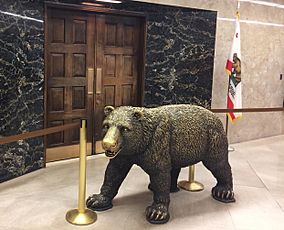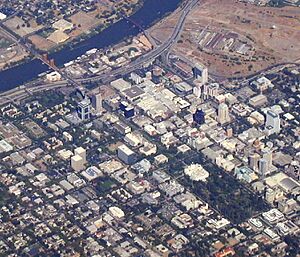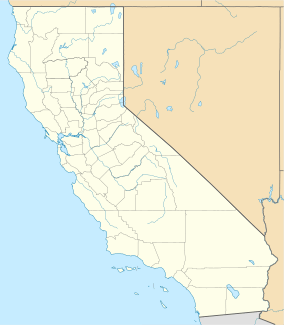California State Capitol Museum facts for kids
Quick facts for kids California State Capitol Museum |
|
|---|---|

A statue of the California state animal, California grizzly bear, inside of the California State Capitol Museum prior to the demolition of the East Annex in 2023
|
|
| Location | Sacramento County, California, United States |
| Nearest city | Sacramento, California |
| Area | 40 acres (16 ha) |
| Established | 1982 |
| Governing body | California Department of Parks and Recreation |
The California State Capitol Museum is a special place in Sacramento, California. It includes a museum inside the California State Capitol building and beautiful gardens around it. This building has been the home of the California State Legislature since 1869. The museum became part of the California State Parks system in 1982. It's a great spot to learn about California's history and government.
Exploring the Capitol Museum
The entire Capitol building feels like a museum, but the main parts are in the basement and on the first floor. In the basement, you can find the tour office and a small theater. This theater shows short films about the Capitol's history. There is also a gift shop and a large mural called "History of California" by Arthur Frank Mathews.
Historic Offices and Exhibits
On the first floor, you can visit restored offices. These once belonged to important state officials. You can see the offices of the Secretary of State, the Treasurer, and the Governor. There are also two rooms that feature changing exhibits. These exhibits show different parts of California's past.
The Columbus Statue's History
For many years, a marble statue called Columbus' Last Appeal to Queen Isabella stood in the center of the Capitol's main rotunda. This statue was created by Larkin Mead. It was a gift to California from a banker named Darius Ogden Mills. In June 2020, leaders of the California Senate and Assembly decided to remove the statue. They explained that its removal was due to the difficult impact Christopher Columbus's arrival had on indigenous peoples. The statue was taken down on July 7, 2020.
Discovering Capitol Park

Capitol Park is a large garden area surrounding the Capitol building. It covers about 40 acres (16 hectares). The park is home to trees and shrubs from all over the world. There are about 1,140 trees in the park, representing over 200 different types. It's like a living museum of plants!
Memorials and Landmarks in the Park
The park also has about 155 memorials. These honor important events and people connected to California. Here are some of the interesting spots you can find, moving from west to east across the park:
West Side of the Park (9th to 10th Streets)
- The Earl Warren Walk: This path is named after a former Governor and Chief Justice. It marks the route he often walked from the Capitol.
- El Soldado Memorial: This memorial honors Mexican American soldiers who served in World War II. It was created by a group of mothers.
- California Peace Officer's Memorial: This special place remembers police officers who died while doing their job. It also honors their families.
Central West Park (10th to 11th Streets)
- California Registered Historical Landmark No. 872: This marker shows that the Capitol Complex is an important historical site.
- The Great Seal of the State of California: A bronze version of California's official seal was placed here in 1952. Later, Native American and Spanish-Mexican seals were added in 2002.
- The Capitol Cornerstone: Near the north entrance, this stone was placed in 1978. It replaced the original cornerstone from 1861.
- The Apollo 14 Moon Tree: This tree was planted in 1976. It grew from a seed that traveled to the Moon with astronaut Stuart Roosa in 1971!
- The Sisters of Mercy Memorial: This honors a group of religious sisters. They came to Sacramento in 1857 to help children, the sick, and the homeless. The land they bought for a school eventually became the site of the Capitol.
- The September 11 Memorial: This memorial includes a plaque and three rose bushes. It was dedicated on the first anniversary of the attacks.
- California Civil War Veterans Plaque: Located at the east entrance, this plaque honors Californians who fought in the American Civil War.
- Senator Capitol Kitty Memorial: This remembers a beloved cat who lived in Capitol Park.
Central East Park (11th to 12th Streets)
- Pioneer Camellia Grove: Created in 1942, this garden honors the early settlers of Sacramento.
- Junípero Serra Statue: A life-sized statue of a Roman Catholic missionary from Spain. At its base, there is a map of California's 21 missions.
- El Camino Real Commemorative Bell: This bell celebrates the original bells placed along the historic El Camino Real route.
- Civil War Memorial Grove: Planted in 1897, this grove has trees grown from saplings from famous Civil War battlefields.
- Reverend Thomas Starr King Memorial: This statue was once in the U.S. Capitol. It was replaced in 2009 by a statue of Governor and President Ronald Reagan.
- Spanish War Veterans Memorial: Often called "The Hiker," this statue honors those who served in the Spanish-American War.
- USS California Ship's Bell: This bell is from a battleship built on the Pacific Coast. The ship was sunk at Pearl Harbor, then raised and rebuilt.
- Reproduction of the Liberty Bell: This is one of 53 copies made in 1953 to encourage people to buy savings bonds.
- World War I Memorial Trees: Planted in 1921, these trees remember the first California soldier who died in that conflict.
- Governor Hiram W. Johnson Memorial Parkway: This area is dedicated to a governor known for his progressive ideas.
- California Department of Transportation Highway Workers Memorial: This memorial remembers CalTrans workers who died in work-related accidents.
- Y-ET-IM TEH-LEI-LI California Indian Grinding Rock: This site honors the history of California's Native American people.
East Side of the Park (13th to 14th Streets)
- The Insectary: Built in 1908 for research, this building now helps the groundskeeping crew.
- The California Firefighters Memorial: This memorial honors firefighters who have died in the line of duty.
- California Veterans Memorial: A tall granite monument honoring California veterans from many wars. These include the Mexican–American War, Civil War, Spanish–American War, World War I, World War II, the Korean War, the Vietnam War, and the Persian Gulf War.
- Purple Heart Monument: Near the Veterans Memorial, this honors veterans who were killed, wounded, or disabled in combat.
Far East Park (14th to 15th Streets)
- The California Vietnam Veterans Memorial: This memorial features life-sized bronze figures of service members. It shows military life in Vietnam and lists the names of Californians killed or missing in action.
- World Peace Rose Garden: This beautiful garden covers about half an acre. It has around 650 roses in over 140 different colors and scents.
- California Native Plant Section: Created in 1911, this section is planted almost entirely with plants that naturally grow in California.
Images for kids
See also











